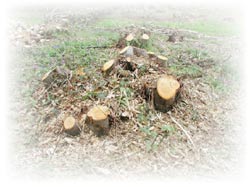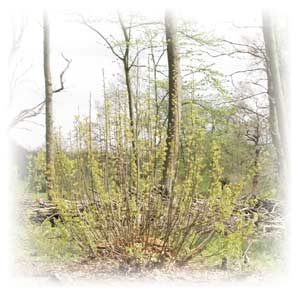Why are the trees being cut down? - Healthy Life Essex
Home » Articles » Sustainability » Why are the trees being cut down?

Coppicing: Understanding Why Trees are Cut Down in Woodlands
Over the winter, you may have walked through your local woodland or nature reserve and discovered that a section of the woodland had been cut down. This can look very destructive, and you might well wonder why should this be allowed to happen. Surely, we should be caring for and protecting our woodlands in an age when deforestation around the world is increasing? The simple answer is that the trees are being cut down (known as coppicing) for the benefit of the woodland, the wildlife, and the flora.
Coppicing is the traditional way of managing British broadleaf woodland, and within Norsey Wood, as with much of the woodland across the UK, this practice has been happening for at least the last 1000 years, if not a lot longer.
Coppicing is undertaken in the winter when the trees are dormant. Coppicing starts when all leaves have fallen from the trees and ends just as the new buds are about to appear. The timings vary each year due to the climate, but it tends to be from the end of November to the beginning of March. If coppicing were undertaken outside of these times it would seriously damage the re-growth of the trees to the extent that the tree stump may die. It would also disrupt nesting birds and damage the flora.
 The trees within each year’s specified area, normally not more than three acres (known as a plot), are felled close to ground level at a slight slope so that rainwater runs off the stump, thus limiting potential rot. Certain trees are left standing within each area. These are classified as standards and tend to be larger and older trees. Keeping them intact will increase the diversification of wildlife and create larger timber in later years.
The trees within each year’s specified area, normally not more than three acres (known as a plot), are felled close to ground level at a slight slope so that rainwater runs off the stump, thus limiting potential rot. Certain trees are left standing within each area. These are classified as standards and tend to be larger and older trees. Keeping them intact will increase the diversification of wildlife and create larger timber in later years.
Once spring arrives and the sap starts to rise within the stump, it has all the energy that used to supply a full grown tree. But now that energy has nowhere to go, so it starts to produce lots of shoots from the stump. Within the first year these can grow up to 5 feet and the following year they can grow to 15 feet or more. You can see that it does not take long for a plot to be re-established!
Because the sunlight can now reach the ground, dormant seeds now have the chance to spring into life. Flowers like foxgloves and wood anemonies appear where there were none visible before; brambles shoot up at an incredible rate and occasionally rarer flowers appear and the odd “unexpected” plant. Recently I found raspberry canes in a plot that was cut last year!
All this new growth is very important to the wild life. It creates new and varied food sources and habitats. Species like the dormouse and certain butterflies, such as the Pearl Bordered Fritillaries, are dependent on coppiced woodlands.
 As the shoots continue to re-grow they start to compete for the light. The stronger shoots grow taller and start to shade out the weaker shoots.
As the shoots continue to re-grow they start to compete for the light. The stronger shoots grow taller and start to shade out the weaker shoots.
With less light, they grow less and eventually die back. This is nature’s way of weeding out the weak. The eventual outcome is that where there was once one trunk growing it now has a number of trunks growing from one stump.
Once there is a full canopy creating shade and reducing the warmth at ground level, the flowers, plants, brambles, etc, will die back until the plot is coppiced again.
There are approximately 165 acres of woodland within Norsey Woods. Twenty-one plots totalling approximately 125 acres are under coppice management, providing this woodland with trees of varying ages and creating the greatest diversification of plants and wildlife.
Each tree species is coppiced after varying lengths of time. For example, Hazel should be coppiced about every six to seven years, whereas Sweet Chestnut should be coppiced about every 21 years.
The differing times were traditionally determined by the intended use of the timber. Hazel had many uses for thatching, hurdle making, etc., but if it was coppiced every 20+ years, it would have been too large to use for those purposes.
 And finally, the timber that has been felled should be used. Traditionally there would have been a use for every piece of wood – nothing would go to waste. These days that is a lot harder to do efficiently, as demand for the same type of timber products has declined. To overcome this, it is necessary to think of new ways to use the wood. Some can be supplied to timber merchants and timber suppliers in Essex, who appreciate locally sourced materials for their unique qualities. There are also individuals who will make products from locally sources wood and nature reserves that have visitor centres often feature such novel products.
And finally, the timber that has been felled should be used. Traditionally there would have been a use for every piece of wood – nothing would go to waste. These days that is a lot harder to do efficiently, as demand for the same type of timber products has declined. To overcome this, it is necessary to think of new ways to use the wood. Some can be supplied to timber merchants and timber suppliers in Essex, who appreciate locally sourced materials for their unique qualities. There are also individuals who will make products from locally sources wood and nature reserves that have visitor centres often feature such novel products.
Historically, smaller parts of the trees like the brushwood and the small side branches were traditionally bundled into faggots for firewood. Not much call for it now, so the brush is now chipped for mulching. While the coppice work is being undertaken, people are continually thinking about what the timber can be used for. The ideas may come fast and furious, but unfortunately, the making of natural timber products takes a lot longer!
We hope that this gives greater insight into why the trees are being cut down, but this is only a brief explanation, and much more information can be found in various publications.
Most importantly, if the woodland is managed correctly, the diverse wildlife and plant life will continue to survive, people will still be able to enjoy the woodland for many more generations to come, and sustainable timber for local use will still be available. This approach also provides local timber suppliers in Essex with responsibly sourced wood, supporting regional timber merchants and fostering eco-friendly practices.
